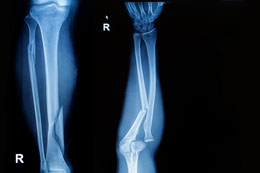Fibula fracture treatment depends on the type of fracture that has occurred. This article attempts to give you a to-the-point explanation on the condition of fibula fracture and how it is managed.

The fibula (also known as the calf bone) is the shorter one of the two bones that make up the major part of the lower legs. The other bone is known as tibia. These bones run between the knee and the ankle. Since the fibula stands parallel to the tibia, any injury to the latter, makes the former highly susceptible to sustain fracture.
Treatment Plan to Manage Fibula Fracture
It is essential to understand that treatment of issues such as bone fractures are something that should not be put off. Otherwise, it can result in poor healing, severe deformity or even potentially life-threatening injuries. As aforementioned, depending upon the type of fracture, the treatment is undertaken. The common types may include:
- A fracture that causes the bone to pierce the skin
- A fracture that does not harm the skin
- One that does not cause the bone to separate into two, although it has been fractured
- Some injuries can cause the bones to be ripped into two or more parts
- In another type of fracture, the fragments that have resulted from the break, are not aligned
- Some fractures can shatter the fibula into several pieces
- And the last kind is a fibula fracture which causes the bone to crack into two, but the pieces do not break away from each other
After diagnosing the type, the first step that is looked after to, is immobilization of the injured leg. For this, the patient may be helped with a splint. Muscle relaxants, or sedatives may be prescribed to the patient, depending on how severe his pain and swelling are. Some people may even require the use of anesthesia before proceeding with any treatment for fibula fracture.
Besides using a splint, the patient may also be advised to make good use of crutches or a cane. The job is to make the injured part immobile thus, prompting quick healing. Pain might be a frustrating symptom that remains for a good period of time until full recovery. To manage this, OTC drugs may be helpful. In some cases, prescription-drugs may be a necessary treatment measure.
Equally important is a treatment process that involves physical therapy routine to reduce the stiffness that has been caused by the fracture, and increase flexibility and range of motion. This may have to be followed for several months for a complete recovery.
The Causes and Symptoms
Generally, there are two types of factors which may affect the fibula. These include injuries, and overuse from repetitive activities. Speaking of injuries, there may be many of them, the most common one being falls. Landing a fall on the thighs, ankles, knees, etc. may easily damage the bone structure of the legs. And since the fibula happens to be more vulnerable, it may get fractured. Accidents, and particularly those caused by vehicles, are also a common culprit for fractures of all the three leg bones (femur, tibia and fibula.). Not to forget, contact sports are also some common causes of fibula fractures. And regarding the overuse of legs, it is the repetitive force that is exerted on the tibia and fibula, that may be responsible for causing tiny fractures. In most cases, as what has been observed by experts, it is the tibia that incurs the damage due to factors such as the above ones, and this may end up in fracturing the fibula. This is so because, there are rarely any cases where damage to the fibula has occurred without the tibia being affected in any way.
Symptoms that are observed commonly, besides the pain, may include:
- Swelling and bruising of the aching area immediately after the damage has occurred
- The area may be tender and warm to touch
- An obvious symptom may be a deformity of the injured leg, that can be mild or severe
- Reduced range of motion thus, inability to walk or moving the injured leg may also be an indication of such fractures
And to conclude, surgery is not always required to treat a fractured fibula. However, it may be otherwise for fractures such as those where the broken pieces are not aligned, or those wherein, the bone has broken into multiple pieces. Adults especially may required to be implanted with devices like plates, rods, etc., to ensure a successful healing process.


 The fibula (also known as the calf bone) is the shorter one of the two bones that make up the major part of the lower legs. The other bone is known as tibia. These bones run between the knee and the ankle. Since the fibula stands parallel to the tibia, any injury to the latter, makes the former highly susceptible to sustain fracture.
The fibula (also known as the calf bone) is the shorter one of the two bones that make up the major part of the lower legs. The other bone is known as tibia. These bones run between the knee and the ankle. Since the fibula stands parallel to the tibia, any injury to the latter, makes the former highly susceptible to sustain fracture.